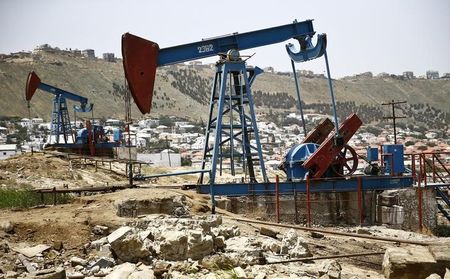Commodities
Oil prices surge, Brent near $92 as Israel-Hamas tensions worsen


© Reuters.
Investing.com– Oil prices rose sharply in Asian trade on Wednesday after a deadly blast at a Gaza hospital appeared to have stymied a U.S. diplomatic effort in the Israel-Hamas war, while industry data showed that U.S. inventories shrank more than expected last week.
The White House said U.S. President Joe Biden will not visit Jordan as part of his Israel trip, after Jordan’s Foreign Minister Ayman Safadi said that a planned summit between U.S., Egyptian and Palestinian leaders will not take place. The trip was seen as an attempt to maintain support for Israel while also placating Arab states and preventing a bigger escalation in the conflict.
The move came just a few hours after an explosion at a crowded hospital in Gaza City reportedly killed hundreds of Palestinians, which was blamed on both Israeli and Hamas forces. The blast drew ire from the international community, and dampened hopes for a swift deescalation in tensions in the Middle East.
This in turn fueled renewed concerns that a spillover of the Israel-Hamas conflict could disrupt crude supplies in the oil-rich Middle East region- a notion that had boosted oil prices through the past week.
The news helped oil prices reverse most losses seen earlier this week, with Brent futures now sitting comfortably above the key $90 a barrel level.
jumped 2.3% to $91.97 a barrel, while surged 2.6% to $87.63 a barrel by 22:20 ET (02:20 GMT).
Fears of an escalation in the Israel-Hamas war, particularly that other Middle Eastern countries could join the fray, had boosted oil prices over the past week, helping them shrug off headwinds from a stronger dollar and fears of higher interest rates.
Stronger-than-expected third-quarter data from world no.1 oil importer China also offered some support to oil markets on Wednesday, as a string of monetary stimulus measures from Beijing appeared to be bearing fruit.
Markets largely looked past reports that the U.S. was close to lifting sanctions on Venezuela, given that any supply unlocked from such a move appeared unlikely to help soothe tight global crude markets.
US stockpiles seen shrinking more than expected- API
In another sign of tight supplies, data from the showed on late-Tuesday that U.S. inventories shrank 4.4 million barrels in the week to October 13, more than expectations for a draw of 1.3 million barrels.
The draw comes after a bumper build in the prior week, which also saw U.S. production reach new peaks. But the API data indicated that U.S. exports had picked up again, while gasoline and distillates consumption remained steady.
Robust and data also pointed to strength in the U.S. economy, likely indicating that fuel demand will remain strong amid tightening supplies. Focus is now on , due later on Wednesday.
Expectations of tighter global oil supplies, following deep production cuts by Saudi Arabia and Russia, underpinned oil prices earlier this year, and are also expected to keep crude supported in the coming months, despite increasing economic headwinds.
More cues on the U.S. economy are due this week, most notably an address by on Thursday.
Commodities
Oil prices rise; U.S. crude inventories plunge, Russia-Ukraine truce eyed
Commodities
India’s Reliance to stop buying Venezuelan oil over US tariffs, sources say
Commodities
Oil prices climb on Venezuela supply worries

 Forex3 years ago
Forex3 years agoForex Today: the dollar is gaining strength amid gloomy sentiment at the start of the Fed’s week

 Forex3 years ago
Forex3 years agoUnbiased review of Pocket Option broker

 Forex3 years ago
Forex3 years agoDollar to pound sterling exchange rate today: Pound plummeted to its lowest since 1985

 Forex3 years ago
Forex3 years agoHow is the Australian dollar doing today?

 Cryptocurrency3 years ago
Cryptocurrency3 years agoWhat happened in the crypto market – current events today

 World3 years ago
World3 years agoWhy are modern video games an art form?

 Commodities3 years ago
Commodities3 years agoCopper continues to fall in price on expectations of lower demand in China

 Economy3 years ago
Economy3 years agoCrude oil tankers double in price due to EU anti-Russian sanctions

























